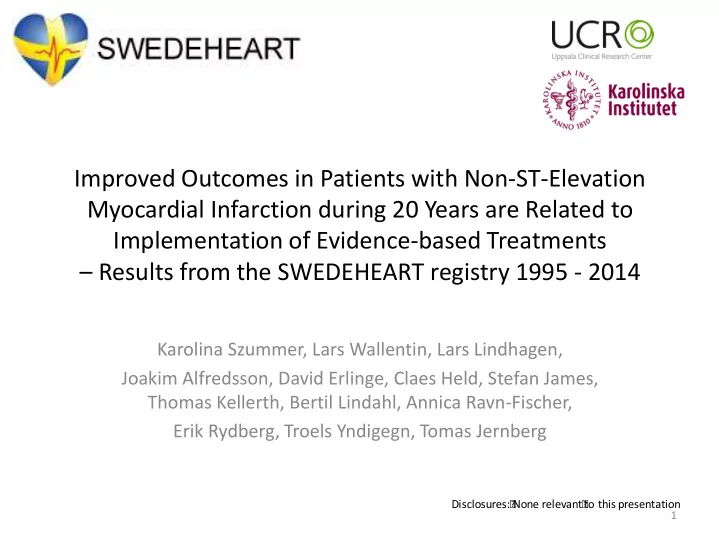

Improved Outcomes in Patients with Non-ST-Elevation Myocardial Infarction during 20 Years are Related to Implementation of Evidence-based Treatments – Results from the SWEDEHEART registry 1995 - 2014 Karolina Szummer, Lars Wallentin, Lars Lindhagen, Joakim Alfredsson, David Erlinge, Claes Held, Stefan James, Thomas Kellerth, Bertil Lindahl, Annica Ravn-Fischer, Erik Rydberg, Troels Yndigegn, Tomas Jernberg Disclosures:� None relevant� to this presentation 1
Background • In patients with NSTEMI clinical characteristics and treatments have changed dramatically during the last two decades • Several RCTs have, one-by-one, proven the efficacy of new medication/intervention alternatives • Treatments were initially mainly focused on the relief of symptoms (e.g. nitroglycerin, beta-blocker) and later also on disease mechanisms (vulnerable stenotic plaques and thrombus formation (e.g. revascularization, platelet inhibitors, anticoagulants, statins) • No study has previously described the overall effects of the new treatment alternatives on long-term fatal and non-fatal outcomes for an entire population over time 2
Aim To describe the changes in treatments and outcomes and the effects of the implementation of new treatments on outcomes in patients with non-ST-elevation myocardial infarction during 20-years in an entire country 3
Methods • Nearly all NSTEMI cases (n=205 693) in Sweden between 1995-2014 were registered in SWEDEHEART and included • Changes in patient characteristics, treatments and outcomes were continuously monitored • 1-year mortality was compared with an age-gender- and calendar-year matched population • Associations between time-period and in-hospital and 1-year outcomes were assessed by stepwise adjustment for baseline characteristics, coronary angiography, primary PCI and discharge medication • Time period related long-term mortality and event rates were assessed during up to 20-years follow-up 4
Baseline characteristics on admission 1995-2014 Variable 1995-96 1997-98 1999-00 2001-02 2003-04 2005-06 2007-08 2009-10 2011-12 2013-14 N 8412 14027 18548 22937 23911 23977 25011 23559 24962 20349 73 74 75 75 75 75 74 74 73 73 Age (years) (64 - 80) (65 - 80) (65 - 81) (65 - 81) (65 - 82) (65 - 82) (64 - 82) (64 - 82) (64 - 82) (64 - 82) Male 65.3% 64.0% 63.6% 61.9% 61.6% 62.0% 61.6% 62.7% 62.6% 63.5% Diabetes 23.4% 24.1% 25.0% 26.3% 26.2% 26.8% 27.1% 27.3% 27.6% 28.8% mellitus Hypertension 37.1% 39.0% 40.6% 44.6% 49.2% 53.3% 60.0% 63.0% 66.1% 67.9% Previous MI 35.6% 36.0% 34.9% 35.0% 34.2% 33.5% 32.9% 32.9% 32.6% 32.0% Previous PCI 3.2% 4.1% 5.0% 6.5% 8.0% 10.6% 13.6% 16.8% 18.9% 20.8% Rales on 37.3% 33.3% 30.5% 28.6% 25.5% 21.2% 17.5% 14.6% 12.9% 11.5% admission Statin on 5.1% 9.2% 14.0% 20.3% 23.7% 28.2% 32.6% 35.6% 36.6% 35.8% admission 5
Treatments at NSTEMI diagnosis and at discharge 100% 90% 80% 70% Aspirin 60% Betablocker� 50% ACE-inhibition/ARB 40% Statin� PCI� 30% Coronary� angiography 20% CABG� 10% Dual� antiplatelet� therapy 0% 1995-1996 1997-1998 1999-2000 2001-2002 2003-2004 2005-2006 2007-2008 2009-2010 2011-2012 2013-2014 8412 14027 18548 22937 23911 23977 25011 23559 24962 20349
1-year outcomes Mortality in NSTEMI in relation to mortality in the general population Crude 1-year outcomes 7
1-year outcomes Crude and adjusted for changes in patient mix and treatments Crude 1-year outcomes Standardized death/myocardial infarction 8
In-hospital outcomes Crude and adjusted for changes in patient mix and treatments Crude in-hospital outcomes Standardized death/myocardial infarction 9
Relative change in risk of CV death/MI per 2-year period All patients: In-hospital CV death/MI In-hospital survivors: One-year CV death/MI 10
Long-term outcomes (1) Death Myocardial infarction 100 100 80 80 Cumulative probability, % Cumulative probability, % 60 60 40 40 Admission year 20 20 0 0 % Years since admission Years since admission 11
Long-term outcomes (2) Heart failure Stroke 100 100 80 80 Cumulative probability, % Cumulative probability, % 60 60 40 40 Admission year 20 20 0 0 % Years since admission Years since admission 12
Limitations • Definition of NSTEMI has changed over time • Detection of myocardial injury has changed over time • The effect of changes in PCI interventions and changes in antiplatetelet therapy cannot be estimated separately 13
Conclusions In patients with NSTEMI admitted to hospitals in Sweden over the last 20 years: • Gradual uptake of new evidence-based treatments • Improvement in long-term survival and reductions in the risk of new ischemic events and heart failure • Improvements in outcomes are mainly explained by implementation of early coronary interventions and also of evidence-based medical treatments • Continued and increased uptake of currently guideline recommended treatments can be expected to further improve outcomes 14
Thanks! • Thanks to Professor Lars Wallentin and late Associate Professor Ulf Stenestrand who together initiated the national myocardial infarction registry RIKS-HIA, which later became the SWEDEHEART registry • Thanks to all at Uppsala Clinical Research centre (UCR) for continuously maintaining and updating the registry • Thanks to all participants and organizers of the SWEDEHEART registry 15
Recommend
More recommend